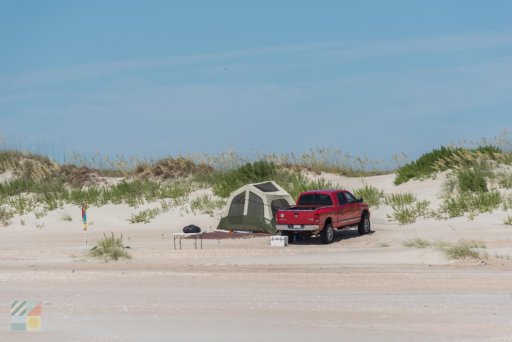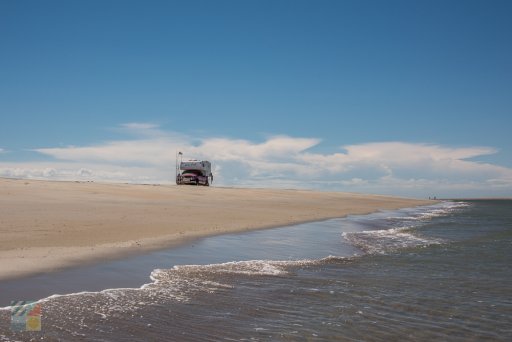A 56-mile long section of the Southern Outer Banks, or Crystal Coast, of North Carolina,
All camping within the park is primitive beach camping: there are no designated campgrounds. Permits are not generally required for camping, but overnight groups of 25 or more are required to obtain a Special Use Permit. Permit applications can be downloaded from the Camping Permits page. All camping is limited to 14 consecutive days.
Campsites must be at least 100 feet from wells, shade shelters, bulletin boards, docks or other structures and at least 100 yards from any cabin or house. Camping is not permitted on Harkers Island, in Portsmouth Village, in the Cape Lookout Light Station complex, in the Cape Village (including the Cape Lookout Coast Guard Station), in long term parking areas, or on property held under private lease. Because it disturbs vegetation, do not camp on top of the dunes.
Visitors are welcome to camp with their vehicles, but vehicles must be kept on the oceanside beach seaward of the primary dunes, not between or on top of dunes. Drivers must follow the regulations for off-road vehicles (ORVs) outlined on the Beach Driving section of the website. Vehicles are not permitted on Shackleford Banks. Parking permits are required for vehicles located in long-term parking lots. No vehicle may be left unattended for over 24 hours without a permit.
While rustic campgrounds and visitors’ centers are found within the National Seashore, there are no commercial facilities, homes, shops, or any development whatsoever. As a result, it’s a refreshing landscape for visitors who want to enjoy a natural Outer Banks setting.
The Banker Ponies are found throughout the South Core Banks and the Shackleford Banks, and are herds of wild horses that freely roam the shoreline. These horses are thought to be the descendants of Spanish mustangs who were shipwrecked along the coastline in the 1500s, and who apparently washed ashore and thrived throughout the centuries. Smaller but more bulky than traditional horses, these feral animals can be spotted throughout the National Seashore, often from the vantage points of vessels cruising through the sound waters.
Tours and sightseeing cruises are available for visitors who want to see these creatures up close, although explorers who encounter the horses while on a beach trip or hike are cautioned to keep their distance. Although they look tame, these horses are completely wild, and should never be approached by humans.
Address: Cape Lookout Rd, Harkers Island, NC 28531
Outer Banks/Coordinates 35.5585° N, 75.4665° W
Lookout lighthouse/Coordinates 34.6228° N, 76.5245° W







https://www.nps.gov/calo/planyourvisit/maps.htm
https://www.nps.gov/calo/planyourvisit/camping.htm
https://www.outerbanks.com/cape-lookout-national-seashore.html
http://www.ncwildhorses.com/
All camping within the park is primitive beach camping: there are no designated campgrounds. Permits are not generally required for camping, but overnight groups of 25 or more are required to obtain a Special Use Permit. Permit applications can be downloaded from the Camping Permits page. All camping is limited to 14 consecutive days.
Campsites must be at least 100 feet from wells, shade shelters, bulletin boards, docks or other structures and at least 100 yards from any cabin or house. Camping is not permitted on Harkers Island, in Portsmouth Village, in the Cape Lookout Light Station complex, in the Cape Village (including the Cape Lookout Coast Guard Station), in long term parking areas, or on property held under private lease. Because it disturbs vegetation, do not camp on top of the dunes.
Visitors are welcome to camp with their vehicles, but vehicles must be kept on the oceanside beach seaward of the primary dunes, not between or on top of dunes. Drivers must follow the regulations for off-road vehicles (ORVs) outlined on the Beach Driving section of the website. Vehicles are not permitted on Shackleford Banks. Parking permits are required for vehicles located in long-term parking lots. No vehicle may be left unattended for over 24 hours without a permit.
While rustic campgrounds and visitors’ centers are found within the National Seashore, there are no commercial facilities, homes, shops, or any development whatsoever. As a result, it’s a refreshing landscape for visitors who want to enjoy a natural Outer Banks setting.
The Banker Ponies are found throughout the South Core Banks and the Shackleford Banks, and are herds of wild horses that freely roam the shoreline. These horses are thought to be the descendants of Spanish mustangs who were shipwrecked along the coastline in the 1500s, and who apparently washed ashore and thrived throughout the centuries. Smaller but more bulky than traditional horses, these feral animals can be spotted throughout the National Seashore, often from the vantage points of vessels cruising through the sound waters.
Tours and sightseeing cruises are available for visitors who want to see these creatures up close, although explorers who encounter the horses while on a beach trip or hike are cautioned to keep their distance. Although they look tame, these horses are completely wild, and should never be approached by humans.
- When you book a passenger ferry, you will usually need to reserve a departure time as well as a return time. Expect to spend at least 2-3 hours exploring the shoreline. Remember you can always catch an earlier ferry ride back as needed, assuming there is room.
- To reach the best shelling beaches in the South Core Banks, (aka, the “Point” of Cape Lookout), visitors without a 4WD vehicle can utilize an on-island taxi service that accesses these beaches for a small additional fee. The “taxi,” (which is a custom pick-up truck), typically waits for potential passengers by the ferry docks by the Cape Lookout Lighthouse.
- Bug spray, bug spray, bug spray! The Cape Lookout National Seashore is notorious for its mosquito population, especially when you venture inland from the waterfront beaches.
- Bring lots of water and snacks. While there are water facilities in Portsmouth Village and at the Visitors Center near the Cape Lookout Lighthouse, there are no other ready supplies of fresh water throughout the 56 mile-long island, and no vending machines or other food vendors.
- Visitors with mobility issues will want to reach the Cape Lookout National Seashore via a vehicle ferry, as the hop off and on the boat can be a little tricky for passengers, and can include a climb up several stairs to the docks. Several of the cabins at Great Island and Long Point may be handicapped accessible – ask specifically about handicapped facilities before you go.
- Bring along extra bags for shells and for trash, and take out everything you bring in.
- Do not disturb the local wildlife, especially the feral horses – they are inherently wild and are not accustomed to being approached by human visitors.
- Public restrooms are found on Portsmouth Island and at the Cape Lookout Visitors Center, but there are no other facilities available throughout the National Seashore.
- Shell hunters will want to try to time a trip a couple days after a hurricane or storm has passed through the area. When the waters calm down after the storm, that’s typically when the best shells make an appearance.
Address: Cape Lookout Rd, Harkers Island, NC 28531
Outer Banks/Coordinates 35.5585° N, 75.4665° W
Lookout lighthouse/Coordinates 34.6228° N, 76.5245° W








https://www.nps.gov/calo/planyourvisit/maps.htm
https://www.nps.gov/calo/planyourvisit/camping.htm
https://www.outerbanks.com/cape-lookout-national-seashore.html
http://www.ncwildhorses.com/








